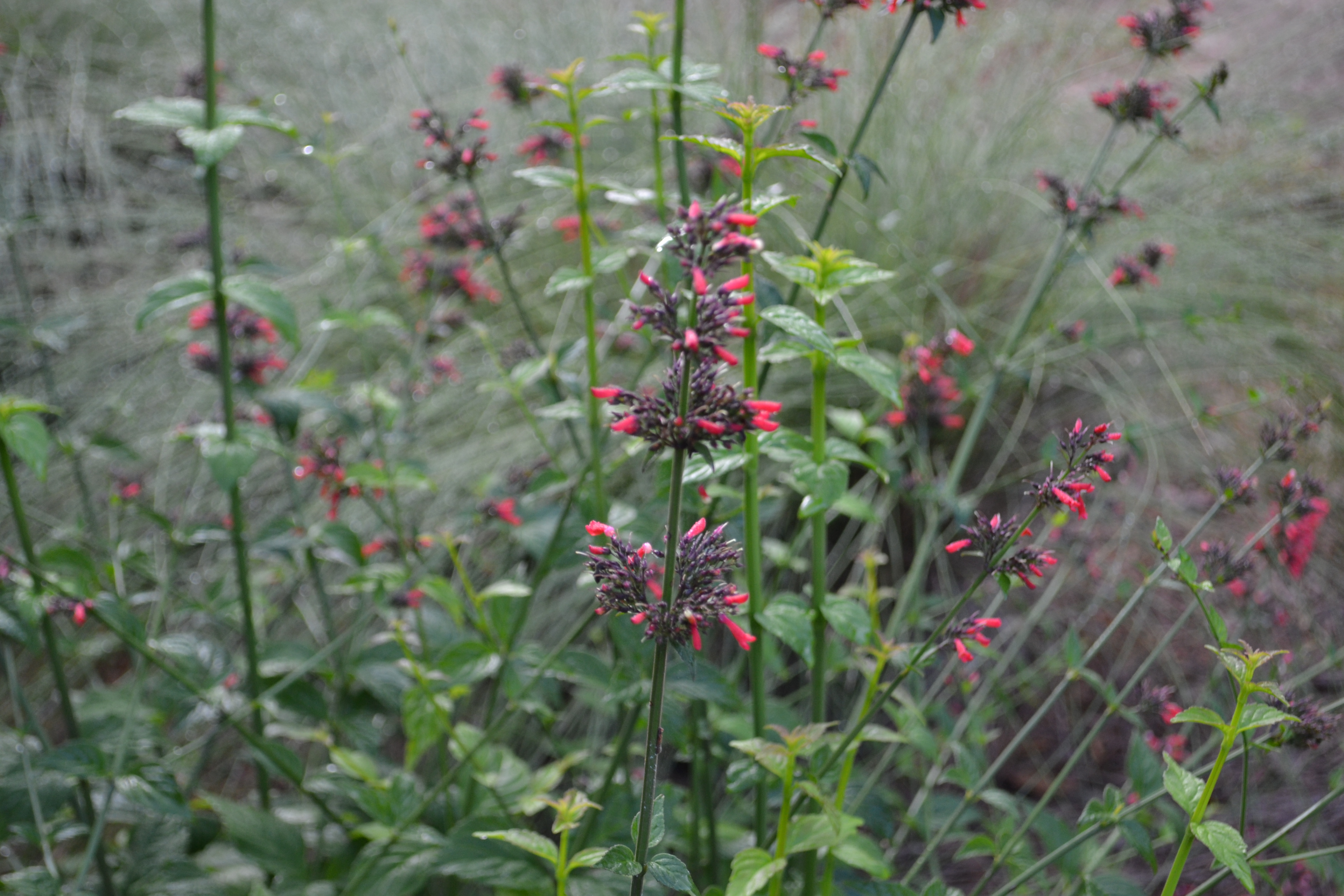
by Beth Bolles | Jul 7, 2013
Bring your own blend of fireworks to the garden this July by adding the Red Rocket Russelia, Russelia sarmentosa to a full sun area.
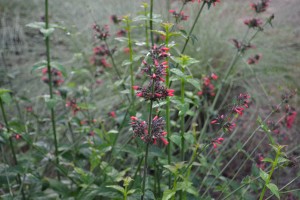
- Russelia sarmentosa. Image Credit Beth Bolles, University of Florida
A favorite perennial to those who grow it, the Red Rocket has many positive qualities that make it a must have for everyone. Plants form a large group of arching stems that grow 5-6 feet in height. Clusters of tubular red flower occur at each node, covering the entire stem in color. Flowering occurs soon after regrowth from winter cold and continues until the first frost. Once established plants perform well with occasional irrigation or a routine rain shower. The added bonus of this colorful perennial is that hummingbirds visit flowers often to feed on nectar.
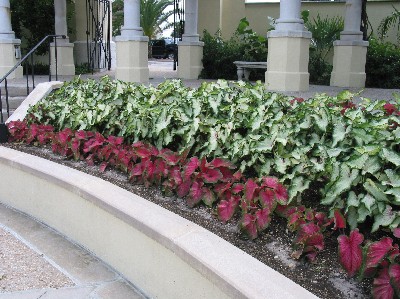
by | Jun 21, 2013
Gardeners crave color in shady areas of their landscapes just as much as they do in sunny areas. Unfortunately, shade-loving plants generally are not so flamboyant, and the selection of colorful bedding plants for shady gardens is limited.
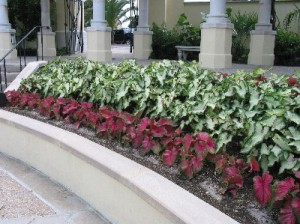
Thank goodness for caladiums. Even in fairly heavy shade they can be counted on to provide color through the summer.
Modern cultivars are primarily derived from caladium bicolor and its hybrids with other caladium species. They are grouped under the name Caladium x hortulanum. Caladiums belong to the arum family, which provides us with many tropical landscape plants and houseplants.
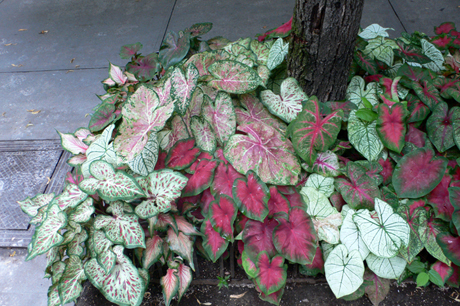
Multiple Varieties of Caladiums in Various Colors.
Caladiums are grown for their attractive foliage, which is produced from knobby brown tubers gardeners often call bulbs. The 6-inch to 12-inch, heart-shaped leaves emerge from the ground on arching stems that are generally 1 foot to 2 feet tall.
The foliage may be splashed with combinations of white, pink, rose, red, burgundy, chartreuse or green – often with several colors combined in wonderful patterns. These bright leaves, with their bold texture, embellish our shady gardens from May until October, when the tubers go dormant.
Caladiums also are remarkably free from major insect or disease problems and thrive in hot, humid weather.
They grow best in shade to part shade (two hours to four hours of direct sun, preferably morning sun). In those conditions they produce lush growth with large, colorful leaves.
Some cultivars are tolerant of more sunny conditions and are successful in beds receiving part to full sun (six hours or more of direct sun), but do avoid hot, dry, sunny locations.
Caladium plants you purchase at nurseries usually have been grown in shady greenhouses, so the foliage often will scorch or burn if you plant them into beds that receive too much direct sun. This results in brown areas and holes literally burned into the leaves. If the cultivar is sun-tolerant, new foliage eventually will emerge and adapt to the sunnier conditions, but I still think caladiums planted in full sun always seem to look stressed.
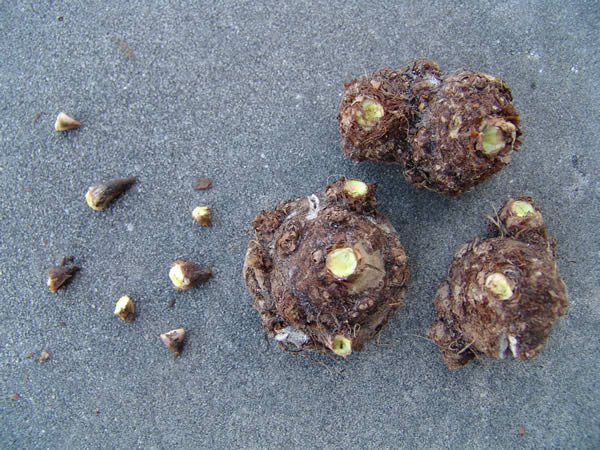
Typical Caladium Tubers Ready for Planting
You can buy caladium tubers now and plant them directly into well-prepared beds. By now, some nurseries have caladium tubers on special sales at a good price, and since our growing season is so long, it is not too late to plant them.
Caladium plants also are available growing in 4-inch to 6-inch pots. They will provide immediate color in the landscape. Plant them about 8 inches to 12 inches apart, and they will grow larger and more beautiful through the summer.
Careful bed preparation will ensure healthy, robust plants. Turn the soil in the area to be planted and then incorporate a 2-inch to 4-inch layer of organic matter such as compost, rotted manure or peat moss. Next, lightly sprinkle the area with an all-purpose fertilizer, following the directions on its package, and rake it into the upper few inches of the soil. As an alternative, a little slow-release fertilizer can be placed around each tuber as it is planted into the bed.
Caladium plants should be planted with the top of the root ball level with the soil of the bed. Plant unsprouted tubers about 2 inches below the soil surface. When planting tubers, you should see growing points or even pinkish-white sprouts on the knobby side of the tuber. That side is planted up. The smoother, rounded side is the bottom of the tuber.
Once they are planted, mulch the bed with 2 inches of your favorite mulch and water in. Keep beds of caladiums well watered during the summer, especially those receiving lots of sun.
The colorful, tropical foliage of caladiums combines beautifully with impatiens, begonias, torenias, liriope, ferns, achimenes, gingers and other shade-loving plants. They generally are more effective when a single color or cultivar is used in a bed or an area of the landscape. If several colors are used, they are most effective when masses or groups of each color are combined in the planting.
In late September or October, cooler temperatures encourage caladiums to go dormant. When grown with poor growing conditions, particularly in areas of deep, heavy shade, the plants will likely produce small, weak tubers that may not return well, whether they are left in the ground or dug and stored. Under the right circumstances and with proper care, however, the tubers you planted this summer can be dug in the fall and planted next April or left in the ground to provide a beautiful display again next year – and for years to come.
All types of caladiums thrive here when they are planted in partly shaded locations. The cultivar you choose is a matter of your individual taste.
Keep in mind that if you are going to be planting caladiums in a sunny location, try these cultivars for better success: Candidum Junior, Carolyn Whorton, Fire Chief, Rosebud, White Queen, Jackie Suthers, Lance Whorton, Miss Muffet, Mumbo, Pink Gem, Red Frill, Sea Gull and Florida Sweetheart.
by Beth Bolles | Jun 17, 2013
There are a couple of possibilities for gardeners who are looking for something a little different than the old favorite French hydrangea. If you want to make your neighbor’s and gardening friends envious, consider adding one of the following selections to your garden.
The first to consider is the ‘Limelight’ hydrangea (Hydrangea paniculata) which is a hardy shrub and performs well in sunshine. New leaves emerge each spring and large greenish-white blooms emerge in the summer. Blooms may offer a color change into the fall, adding a delicate pink shade. This hydrangea should definitely be installed where it can be viewed and can grow 6-8 feet in height with a similar spread. Once established, it can be tolerant of some drought but will require moisture during extended dry periods.
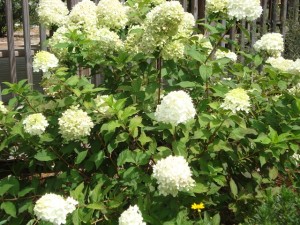
If you have a garden with more dappled shade, the ‘Fuji Waterfall’ hydrangea is a good selection. This hydrangea will require a soil with more consistent moisture and will offer interesting lacecap blooms that appear to cascade over the dark green leaves. Growth will have a layered look with plants reaching about 3 to five feet in height.
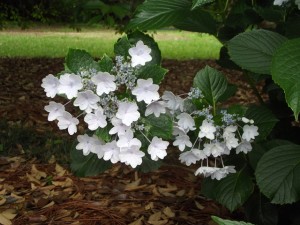
For more information on newer selections of hydrangeas for our climate visit the University of Florida publication New Hydrangeas for North and Central Florida: Bigleaf and Mountain Hydrangeas
by Sheila Dunning | Apr 12, 2013
 This month, recognized by the Senate and Florida’s governor, reminds diggers why calling 811 before all outdoor digging projects is important to your safety. Before installing a mailbox, fence, deck, garden or tree make sure to call Sunshine 811 to have underground lines marked. 811 is the free national number designated by the Federal Communications Commission. It notifies utility companies, who in turn send their professional locators to identify and mark the appropriate location of underground line with paint and flags in colors that identify the utility type. The following colors represent the seven various utilities: red – electric, orange – communications (telephone, cable tv), blue – potable water, green – sewer, yellow – gas, purple – reclaimed water, and white – site of intended excavation. To learn more about color designation and their corresponding utility go to: http://www.call811.com/faqs/default.aspx. Locate marks are good for 30 calendar days. Any work beyond that requires another call to 811. If the marks are destroyed before your project is done, stop digging and call 811.
This month, recognized by the Senate and Florida’s governor, reminds diggers why calling 811 before all outdoor digging projects is important to your safety. Before installing a mailbox, fence, deck, garden or tree make sure to call Sunshine 811 to have underground lines marked. 811 is the free national number designated by the Federal Communications Commission. It notifies utility companies, who in turn send their professional locators to identify and mark the appropriate location of underground line with paint and flags in colors that identify the utility type. The following colors represent the seven various utilities: red – electric, orange – communications (telephone, cable tv), blue – potable water, green – sewer, yellow – gas, purple – reclaimed water, and white – site of intended excavation. To learn more about color designation and their corresponding utility go to: http://www.call811.com/faqs/default.aspx. Locate marks are good for 30 calendar days. Any work beyond that requires another call to 811. If the marks are destroyed before your project is done, stop digging and call 811.
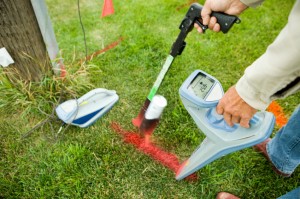
Hitting an underground utility line while digging can cause injuries, utility service outages to an entire neighborhood and damage to the environment. The depth of utility lines varies, and there may be multiple utility lines in one common area. Even if you think you know where an underground line is, time tends to change things. Erosion or tree roots can shift those utility lines. Failure to call before digging results in one unintentional utility hit every eight minutes nationwide. You could also be financially affected with costly fines and high repair costs.
The Common Ground Alliance (CGA) Damage Information Reporting Tool (DIRT) provides industry stakeholders with a way to anonymously submit data into a comprehensive database for analysis of the factors that lead to events. An event is defined by the CGA DIRT User’s Guide as “the occurrence of downtime, damages, and near misses.” The number of events submitted to DIRT for 2011 totaled 207,779. However, according to CGA DIRT “when a call is made to the one call canter (811) prior to excavation, 99% of the time there will be no damage”.
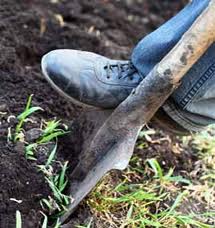
Calling 811 in Florida is the law. At least two full business days before digging, do-it yourselfers and professional excavators must contact 811 by phone to start the process of getting underground utility lines marked. This is a free service. Be sure that all utilities have been marked before grabbing the shovel. If you don’t see locate marks, don’t assume there are no underground utility lines. Verify with the Sunshine 811 Positive Response system. Follow up on your one call ticket by contacting 811 again on the third day. Sunshine State One Call is a not for profit corporation which began with the 1993 adoption of the “Underground Facility Damage Prevention and Safety Act,” Chapter 556, Florida Statutes. Online you can visit: www.online811.com, or call (800) 852-8057. If you provide a valid e-mail when requesting your locate ticket, positive response updates will automatically be sent to you when all utilities have responded. For more information on Florida’s law, visit www.Sunshine811.com.
by Mary Salinas | Mar 27, 2013
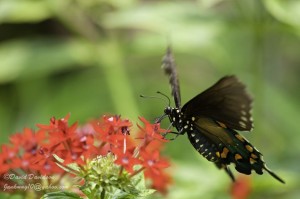
Photo courtesy of David Davidson
Butterflies are not only beautiful to look at in the landscape; they serve as important pollinators of fruiting plants. Attracting them to the garden and incorporating some features to get them to stay and reproduce involves advanced planning. Some steps to achieve butterfly garden optimization are outlined below.
- Choose a location that provides some protection from wind. Trees and shrubs that provide wind protection also serve as a safe harbor from rain and predators.
- The garden should offer both sunny and partially sunny environments.
- Ensure that any new plantings have access to a convenient irrigation source. A plentiful water source allows butterflies to be successfully established and maintained in good health.
Now plants need to be chosen. Adults feed on the nectar of many flowering trees, shrubs, perennials, and annuals. Fortunately, there are usually many choices that will meet diverse site requirements and varied taste preferences. In order to retain garden butterflies, certain plants need to be available to serve as host plants for their young. Here are a few hits to assist with this selection process.
- Determine which species of butterfly is common in a given geographical area. Most species have very few plants on which the caterpillars can feed, so host plants need to be chosen wisely.
- Determine whether any of the existing plants are host plants and if they are appropriate for a butterfly garden. For example, cassia is a host plant for the Cloudless Sulphur and citrus is a host plant for the Giant Swallowtail.
- In choosing nectar plants, select those that are native or Florida-Friendly as they are lower maintenance, and less troublesome in the long run.
- Choose plants that have flowers in a variety of color, size, and shape. Different butterflies like to feed at different elevations, so choose trees, shrubs, perennials, and annuals of varying heights.
- In order to have nectar available throughout the time when the butterflies occur, include plants that bloom at different times of the year. And include some plants that bloom all the time, like pentas or moss verbena.
Larger plants should be placed in the background with smaller plants layered in the foreground. When planting smaller annuals and perennials, place them in masses to better attract the butterflies. Consider placing host plants in an area that is in close proximity to the nectar plants, but in an area of your garden that is not a focal point. Host plants can get quite ragged looking from hungry caterpillars!
Good maintenance practices will enhance garden health. Regular fertilization, and as needed irrigation, will help keep garden plants in bloom and healthy – healthy plants are less susceptible to disease and pests. Avoid pesticides as they may harm butterflies and other beneficial insects. Never use a Bt or systemic pesticide since these target butterfly larvae. Lower risk oils or soaps are useful in treating localized insect infestations however. Lastly, be aware of beneficial insects that will help achieve satisfactory pest control.
Once the plants are placed there are several things to do to complete the butterfly garden.
- Add a spot where water can puddle on the ground for the adult butterflies to drink. They require minerals from the soil that get dissolved in the water.
- Also add a rock or log in a sunny spot where butterflies can rest and sun themselves.
- Consider placing a comfortable place for you to sit and enjoy the beauty of your garden and its inhabitants!
For more infortmation on butterfly gardening and for a plant list, please check out Butterfly Gardening in Florida
Enjoy the Butterflies !












